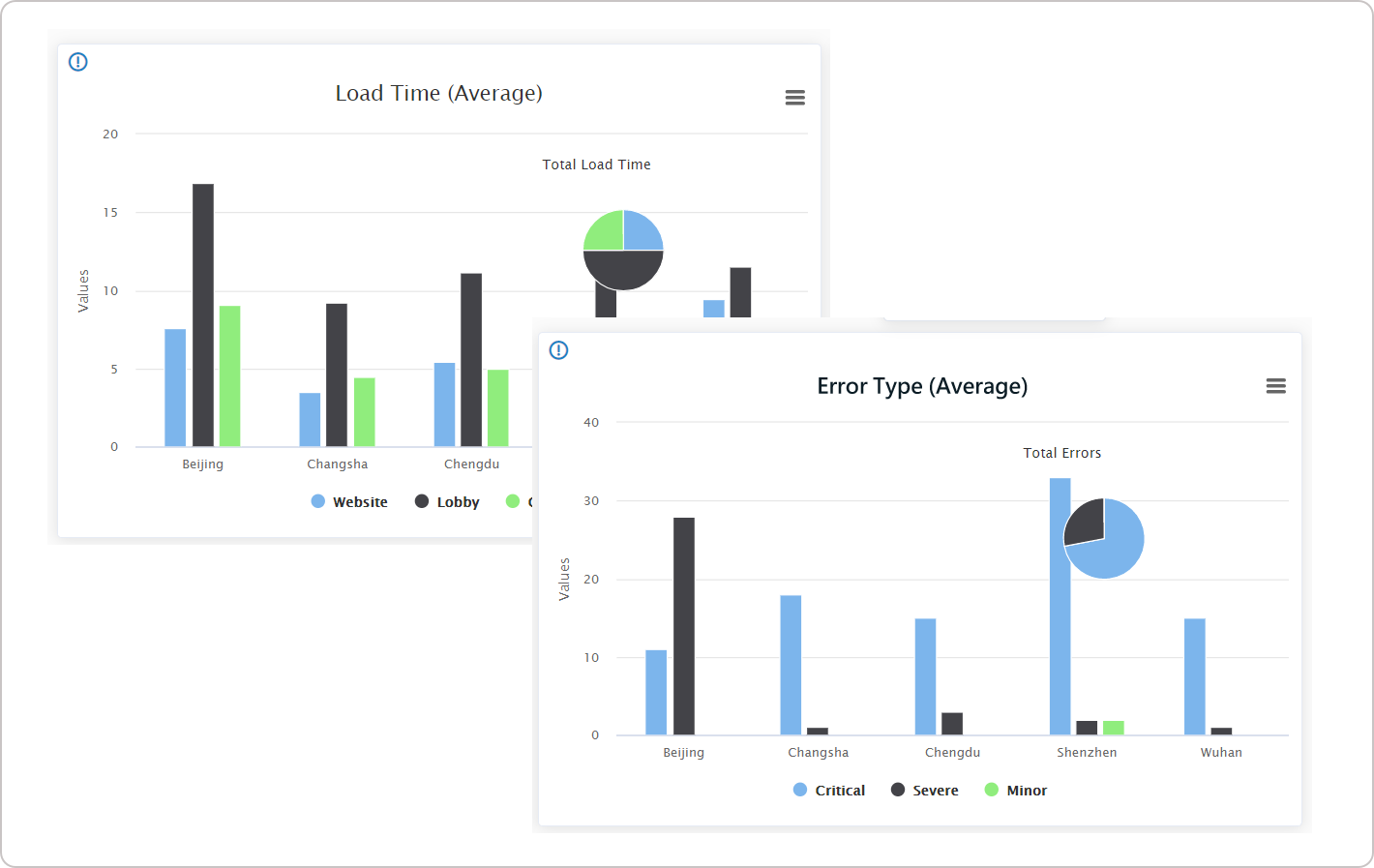A high-performing website is essential to keep visitors on your site and offer an enjoyable user experience. While this is true in any market, Chinese websites are faced with a unique set of challenges that requires an understanding of regulations and a diverse target audience. Therefore, a combination of manual and synthetic (automated) testing is the only way to ensure you are maximizing performance, the user experience, and complying with Chinese regulations.
Today, we will discuss the importance of manual testing and how it can identify root causes and lead to better website performance in China. While manual testing is crucial, it is not a replacement for synthetic testing. Both offer a unique array of benefits that help marketers gain insights and identify root problems.
How slow load speeds affect your business
Online consumers have become accustomed to ultra-fast page load speeds and a seamless experience navigating web pages. Internet research shows that 53% of mobile users will abandon a page if it takes longer than 3 seconds to load. Sites that load under 5 seconds were shown to increase average sessions by 70% and the bounce rate dropped by 35%.
Considering that the industry average conversion rate is around 2.35%, a high-performing website is essential, heightening the need for marketers to do substantial manual testing to get to the bottom of performance issues.

Challenges in the Chinese market
China's population of over 1.4 billion people and rapidly growing middle class attracts businesses worldwide. However, it is common for operators to enter the market without knowledge of local devices, app stores, cross browsers, the Great Firewall of China (GFoC), the diverse population, and the expansive region.
Insufficient understanding of the Chinese market
Many massively successful technology companies have attempted to capture the Chinese market. The most significant retreat from China came in 2018 after Google pulled Project Dragonfly, an attempt to meet the government's demands and roll out a Chinese version of the search engine. Google had previously set up shop in China in 2006 only to be pulled 4 years later after a purported security breach. Disagreements with Chinese regulators and falling revenue were speculated as the cause for the withdrawal.
While entering the Chinese market can be incredibly prosperous for foreign companies, experience, knowledge of the region, collaboration with partners, understanding the regulatory environment, and a commitment to the market are needed to succeed.
The Great Firewall of China
Web traffic in China is monitored by the well-known Great Firewall of China or GFoC. Regulators have complete control over what websites are accessible from international IP addresses.
Complying with regulations to gain access to China is only the first battle when entering the market. The extra layers of latency can dramatically reduce page load speeds. In addition, the GFoC uses deep packet inspection to monitor the internet, creating a high chance of data becoming lost during a request. Both factors exponentially increase page load speeds and hinder the user experience. Therefore, manual testing by a firm with a deep knowledge of the challenges presented by the GFoC is necessary to gain insights into the bottlenecks to web performance.
Poor ISP connection
Connection speeds vary dramatically depending on the location in China. The geography is incredibly expansive, and there are only 3 state-run service providers. When accessing foreign-hosted websites, limited optic fiber entry and exit points create bottlenecks for China's billion-strong internet users.
Many businesses test their websites in only one region, report sufficient page load speeds, and move on. Unfortunately, they fail to understand that hundreds of millions of users could experience lagging pages in other areas.
Other problems
Internet infrastructure, including DNS, servers, and CDN is less reliable than in other markets. DNS, in particular, faces issues of high packet loss and latency in China due to unreliable protocol UDP.
Chinese web traffic is also hindered by compatibility problems such as scripts, plugins, and programming that isn't supported in China.
Websites can also be poorly built. This isn't unique to China, but foreigners face many other challenges when introducing a website to the market, so following best web development practices become increasingly important.
How manual testing can identify poor performance
A robust testing strategy is the only way to ensure that most Chinese internet users will experience the lowest possible page load speeds possible. In addition, testing by a firm that is knowledgeable about the unique Chinese demographic will ensure an optimal user experience. Of course, manual testing isn't the sole solution, but it should play a substantial part in your development process.
Below are the 5 ways manual testing can identify the root causes of poorly performing websites in China.

Last-mile tests
The last mile in telecommunication terms refers to the end user's connectivity and experience on the web page. These tests are so necessary in China because separate ISPs in China offer different speeds; monitoring the last mile will give you an idea of the actual page load speeds throughout China.
Once you have a clear picture of how each region of China is experiencing your website, you can formulate an actionable plan specific to each area and make changes if necessary.
Ad-hoc tests
When testing needs to be carried out quickly or on a specific part of the site, a manual ad-hoc test is an optimal solution. Other instances include testing before a launch, verifying a critical bug was resolved and ensuring offshore content successfully bypassed the GFoC.
Usability testing
Usability testing checks a complete assessment of page elements, including menus, internal and external links, and general navigation. These types of manual tests deliver valuable insights into quality assurance and the overall user interactions on the page.
Compatibility testing
Cross-browser testing in China is extremely important. Unlike the U.S. and Europe, China has a wide variety of internet browser options. Compatibility testing also covers how your website or application is optimized for different devices and screen sizes commonly used in China. Click here to learn more about why cross-browser testing is so important for China.

Competition benchmarking
Carrying out tests on competitors' web pages is critical, especially for foreign businesses looking to compete in China. Manual tests will return valuable insights giving you a comprehensive perspective of their strengths and weaknesses, and identifying areas where you can capitalize.
Advantages of manual testing
Testing a website in real-time by a real person is necessary for the Chinese market because it is the only way to identify specific problems. For instance, the firewall system is uncoordinated and ad-hoc, allowing some websites to bypass the system and others to be blocked in particular regions. The reason is that China's ISPs prevent I.P. addresses from being routed at internet gateways. Using only automated (synthetic) testing isn't comprehensive enough to cover every region and reach maximum coverage. An effective manual testing strategy includes utilizing quality assurance engineers in different cities to gain a complete understanding of the website or application's performance.
Manual vs. synthetic testing
Manual testing offers unique advantages over synthetic testing specific to the Chinese market. As we mentioned, the infrastructural differences across China’s landmass aren’t identified by automated tests. In addition, the diversity of browsers and devices presents a challenge when strictly utilizing a synthetic test.
The most significant difference is gathering valuable insights related to the user experience from a human’s point of view. Manual testing offers real-time analytics for complex applications such as video streaming, financial products, and interactive games that synthetic testing will miss. In the future, testing may evolve to eliminate the need for actual users to test websites or applications, but we are far from that point. Today, there is nothing comparable to assessing the user experience other than utilizing a knowledgeable human with the necessary tools and know-how as well as a well-detailed testing strategy.
Manual vs. VPN testing
Many international companies rely on VPN testing rather than actual humans to check web performance. So we tested 3 Canadian websites with 3 VPNs to find which type of test is more reliable for website maintenance. Our results found that the data from the 3 VPNs wasn’t stable. The differences in the path and bandwidth of each VPN create an unpredictable connection, leading to inconsistent results.

Our research found that the connection route is constant, and the resource access differential to the terminal is minimal, confirming that manual testing is more stable and isn’t altered by outside interference.
Click here to take a closer look at our VPN testing vs manual testing process and analysis.
A customized total solution from GoClick China
GoClick China offers an all-inclusive solution to website and application testing. We utilize a combination of manual and synthetic testing to ensure foreign companies can be successful when breaking through to the Chinese market.
Our clients have experienced success introducing products into China because of our deep understanding of the market and valuable insights. We understand that running tests isn't enough to compete in China; our engineers are familiar with foreign companies' complex challenges. We use our experience to prepare companies to enter the market along with our successful manual and synthetic testing strategies.
Click GoClick China to learn how to help your website get in front of your target market and perform as well or better than the local competition.
Here at GoClick China, we specialize in website testing in China. Let us know which testing method works for you, and we will have a solution for you.
Please check out our other articles to learn more about succeeding in China.


